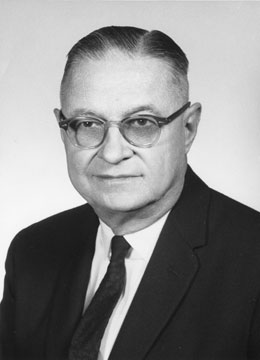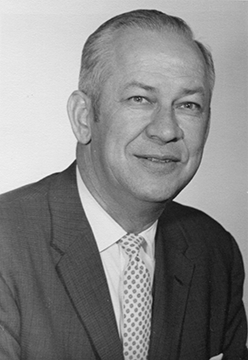PC continues growth during reign of 13th and 14th presidents
PC’s 13th President leads college through prosperous years of growth
Marshall W. Brown (1945-1963)
 When Marshall Walton Brown, a graduate of Centre College, was named the 13th President of Presbyterian College, he had been a history professor at PC since 1925 and dean since 1928. He took on additional administrative duties during the presidency of his predecessor, William P. Jacobs II, and was well prepared when he took office in 1945.
When Marshall Walton Brown, a graduate of Centre College, was named the 13th President of Presbyterian College, he had been a history professor at PC since 1925 and dean since 1928. He took on additional administrative duties during the presidency of his predecessor, William P. Jacobs II, and was well prepared when he took office in 1945.
In more than 18 years as president, Dr. Brown quadrupled the college’s assets, increased the endowment from $200,000 to $1.4 million, and tripled professors’ salaries. Three new buildings were built and plans were in the works for three more.
As World War II came to a close, The Blue Stocking and The Pac Sac resumed publication and PC welcomed veterans back to the campus. Intercollegiate sports became a means of bridging the age gap between freshmen and veterans. Ben Hay Hammet ’43, returned to campus in 1949 to develop a comprehensive program of alumni and public relations, receiving national awards for publications and for alumni support.
Post-war enrollment at PC was up to 476 in 1947 and students were housed all over, including Springs Gymnasium and the second floors of Judd Hall and the student center house. In addition to this, others were scattered in accommodations across town. By 1955, Laurens Hall had been updated and Bailey Hall dormitory was ready when 509 students arrived on campus, according to Ben Hay Hammet, The Spirit of PC. Douglas House (1958) and Belk Auditorium (1960) were later completed with plans for Richardson Science Hall, Greenville Dining Hall, and a women’s dormitory awaiting funding.
As the student body continued to grow, so did the physical footprint of the college. Under Dr. Brown, the campus grew to 175 acres with the purchase of two tracts of land adjacent to the campus in 1962, according to Ben Hay Hammet’s The Spirit of PC.
Having completed his most successful year as president, Dr. Brown submitted his resignation to the board of trustees in March 1963.
Brown’s presidency was memorable for PC in many ways. His first official act as president was to fire his wife, Lillian Gross Brown, longtime Registrar and originator of the Bee Mail letters to PC soldiers during WWII. At her 100th birthday celebration, Mrs. Brown said, “I just went out for a walk and cried.”
Marshall Brown spent over 38 years on the campus of PC, moving from the history department to the Dean’s office to the President’s office. Following his retirement, Brown served as the SC coordinator for the Higher Education Facilities Act. He and his wife, former Registrar Lillian Gross Brown, retired in Clinton, where he died in 1986.
PC’s 14th president sees the college through racial integration and continued growth
Marc C. Weersing (1963-1979)
 Marc Calvin Weersing, pastor of the Spartanburg First Presbyterian Church and a member of PC’s Board of Trustees, was a graduate of Calvin College, Calvin Theological Seminary, and Columbia Seminary. While serving as a trustee of the college, he was co-chairman of the 1962 capital campaign which secured more than $1.8 million for PC from the Synod of South Carolina. He also served five years on the Board of World Missions and on the General Assembly of the Presbyterian Church US Presbyterian Development Fund, Committee of Evangelism, and on the General Council.
Marc Calvin Weersing, pastor of the Spartanburg First Presbyterian Church and a member of PC’s Board of Trustees, was a graduate of Calvin College, Calvin Theological Seminary, and Columbia Seminary. While serving as a trustee of the college, he was co-chairman of the 1962 capital campaign which secured more than $1.8 million for PC from the Synod of South Carolina. He also served five years on the Board of World Missions and on the General Assembly of the Presbyterian Church US Presbyterian Development Fund, Committee of Evangelism, and on the General Council.
Dr. Weersing was nominated as the 14th president of PC by trustee Dr. Eugene T. Wilson from a field of almost twenty candidates. During his sixteen years as president, Dr. Weersing presided over full racial integration of the student body, as well as co-education, and the turmoil of the 1960-1970s. Enrollment continued to increase during his tenure and the faculty almost doubled with more than 70% of faculty holding doctoral degrees.
Expansion of the campus continued with eight major buildings, including the James H. Thomason Library, Belk and Georgia dormitories, Templeton Physical Education Center, and the fraternity court being added to the campus during his presidency. In July 1964, construction began on three buildings simultaneously: a new dormitory for women, Richardson Science Hall, and Greenville Dining Hall, all planned and funded by the Synod of South Carolina’s 1962 fundraising campaign. These three buildings were the first structures on the college’s new East Plaza.
Upon the completion of Clinton Hall in mid-1965, full coeducation of the campus would take effect that fall. In 1965, PC enrolled 90 women students and by 1968, the total enrollment of 720 included 210 female students.
The turbulent 1960-70s at PC focused primarily on local concerns to students including mandatory assemblies, drinking rules, ROTC 2-year requirement, dorm visitation, dress code, and curfews. Computerized registration and scheduling occurred under Dr. Weersing’s administration and the college calendar moved to a 13-13-7 week semester schedule. The off-campus study was first introduced at PC during the seven-week May term after 1970.
When Dr. Weersing announced his retirement, “the physical plant of Presbyterian College stood out as an attractive symbol of progress and permanence: a Jeffersonian pattern of colonial Georgian buildings spread around three plazas on an oak-shaded campus of 175 acres,” says Ben Hay Hammet in The Spirit of PC.
After his retirement, Dr. Weersing remained in Clinton, where he died in 1986.
Source: Information provided by PC Archives
